AUDI A3 CABRIOLET 2015 Owners Manual
Manufacturer: AUDI, Model Year: 2015, Model line: A3 CABRIOLET, Model: AUDI A3 CABRIOLET 2015Pages: 302, PDF Size: 73.83 MB
Page 231 of 302
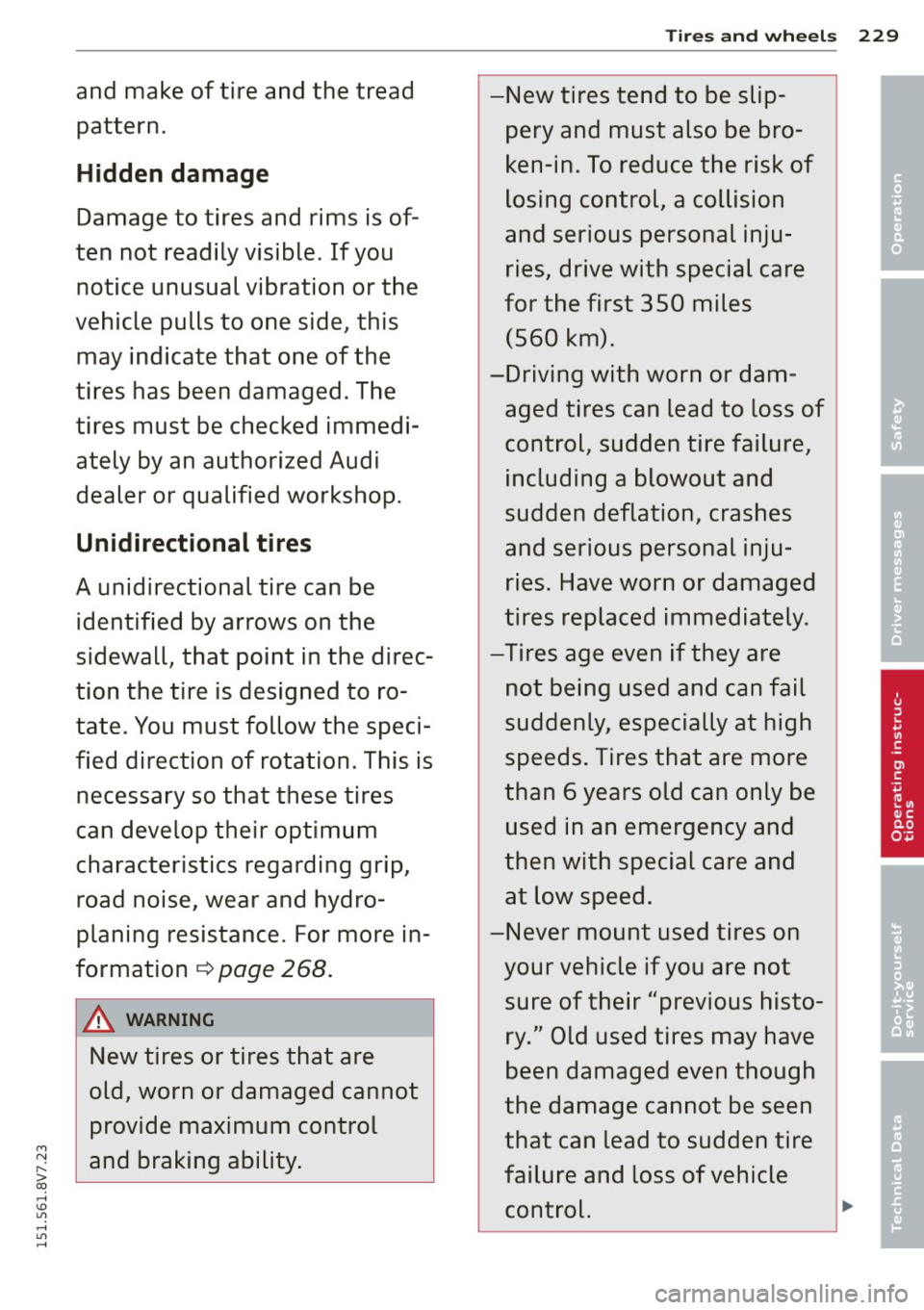
M N
" > co ,...., \!) 1.1'1 ,...., 1.1'1 ,....,
and make of tire and the tread
pattern.
Hidden damage
Damage to tires and rims is of
ten not readily visible. If you
notice unusual vibration or the
vehicle pulls to one side, this may indicate that one of the
tires has been damaged . The
tires must be checked immedi ately by an authorized Audi
dealer or qualified workshop.
Unidirectional tires
A unidirectional tire can be identified by arrows on the
sidewall, that point in the direc
tion the tire is designed to ro
tate. You must follow the speci
fied direction of rotation. This is necessary so that these tires
can develop their optimum
characteristics regarding grip,
road noise, wear and hydro
planing resistance. For more in
formation
¢ page 268.
A WARNING
-
New tires or tires that are
old, worn or damaged cannot
provide maximum control
and braking ability.
Tires and wheels 229
-New tires tend to be slip
pery and must also be bro
ken-in. To reduce the risk of
losing control, a collision
and serious personal inju
ries, drive with special care
for the first 350 miles (560 km).
-Driving with worn or dam aged tires can lead to loss of
control , sudden tire failure,
including a blowout and
sudden deflation, crashes and serious personal inju
ries. Have worn or damaged
tires replaced immediately.
-Tires age even if they are
not being used and can fail
suddenly, especially at high
speeds. Tires that are more
than 6 years old can only be
used in an emergency and
then with special care and at low speed.
-Never mount used tires on your vehicle if you are not
sure of their "previous histo
ry." Old used tires may have
been damaged even though
the damage cannot be seen
that can lead to sudden tire
failure and loss of vehicle
control.
' •
•
' •
Page 232 of 302
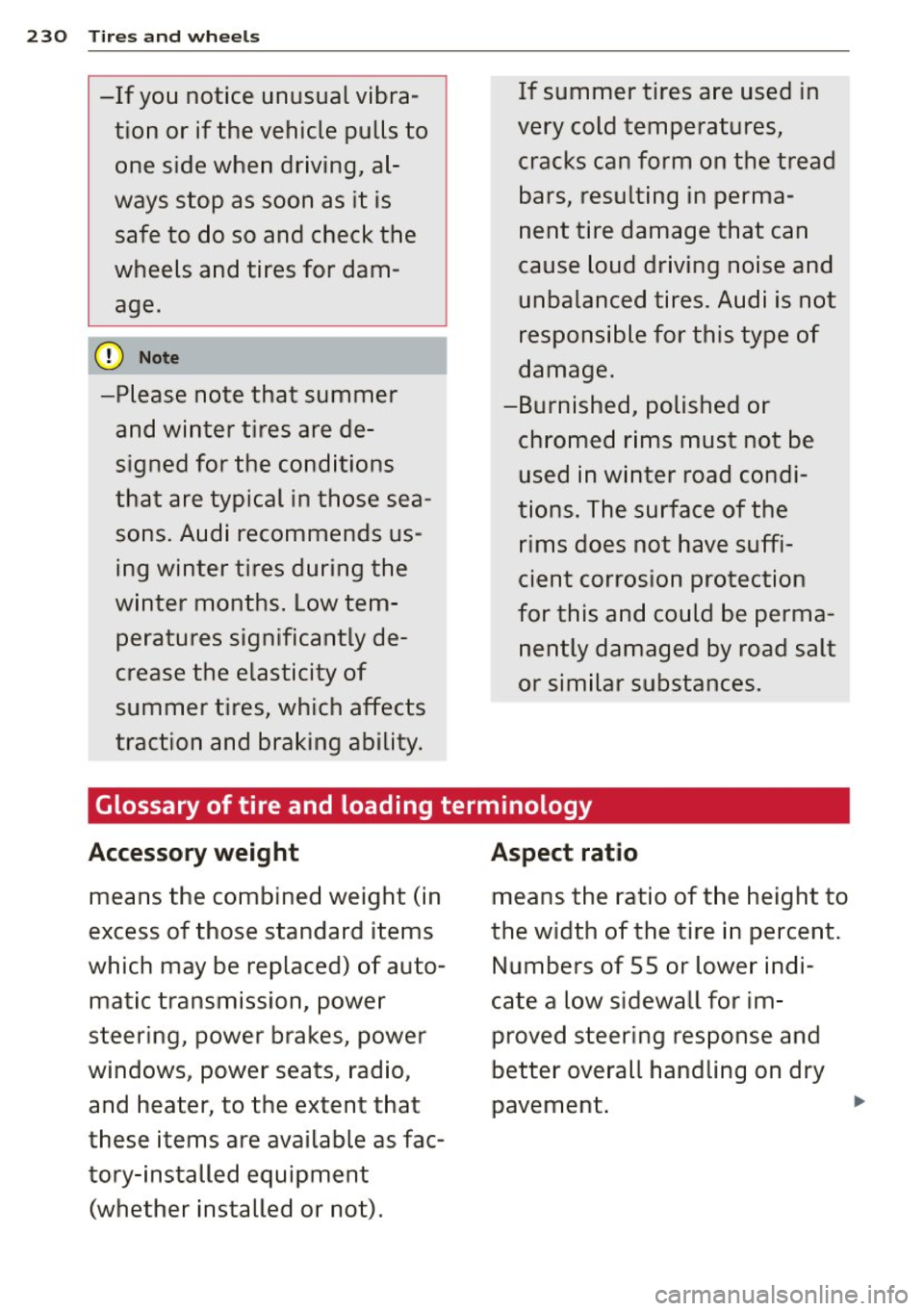
230 Tires and wheels
-If you notice unusual vibra
tion or if the vehicle pulls to
one side when driving, al
ways stop as soon as it is
safe to do so and check the
wheels and tires for dam
age.
0 Note
-Please note that summer and winter tires are de
signed for the conditions
that are typical in those sea
sons. Audi recommends us
ing winter tires during the
winter months. Low tem peratures significantly de
crease the elasticity of
summer tires, which affects
traction and braking ability. If summer tires are used
in
very cold temperatures, cracks can form on the tread
bars, resulting in perma
nent tire damage that can
cause loud driving noise and
unbalanced tires. Audi is not
responsible for this type of
damage.
-Burnished, polished or chromed rims must not be used in winter road condi
tions. The surface of the
rims does not have suffi
cient corrosion protection
for this and could be perma
nently damaged by road salt
or similar substances.
Glossary of tire and loading terminology
Accessory weight
means the combined weight (in
excess of those standard items
which may be replaced) of auto matic transmission, power
steering, power brakes, power
windows, power seats, radio, and heater, to the extent that
these items are available as fac
tory-installed equipment (whether installed or not).
Aspect ratio
means the ratio of the height to
the width of the tire in percent.
Numbers of 55 or lower indi
cate a low sidewall for im
proved steering response and
better overall handling on dry
pavement.
...
Page 233 of 302
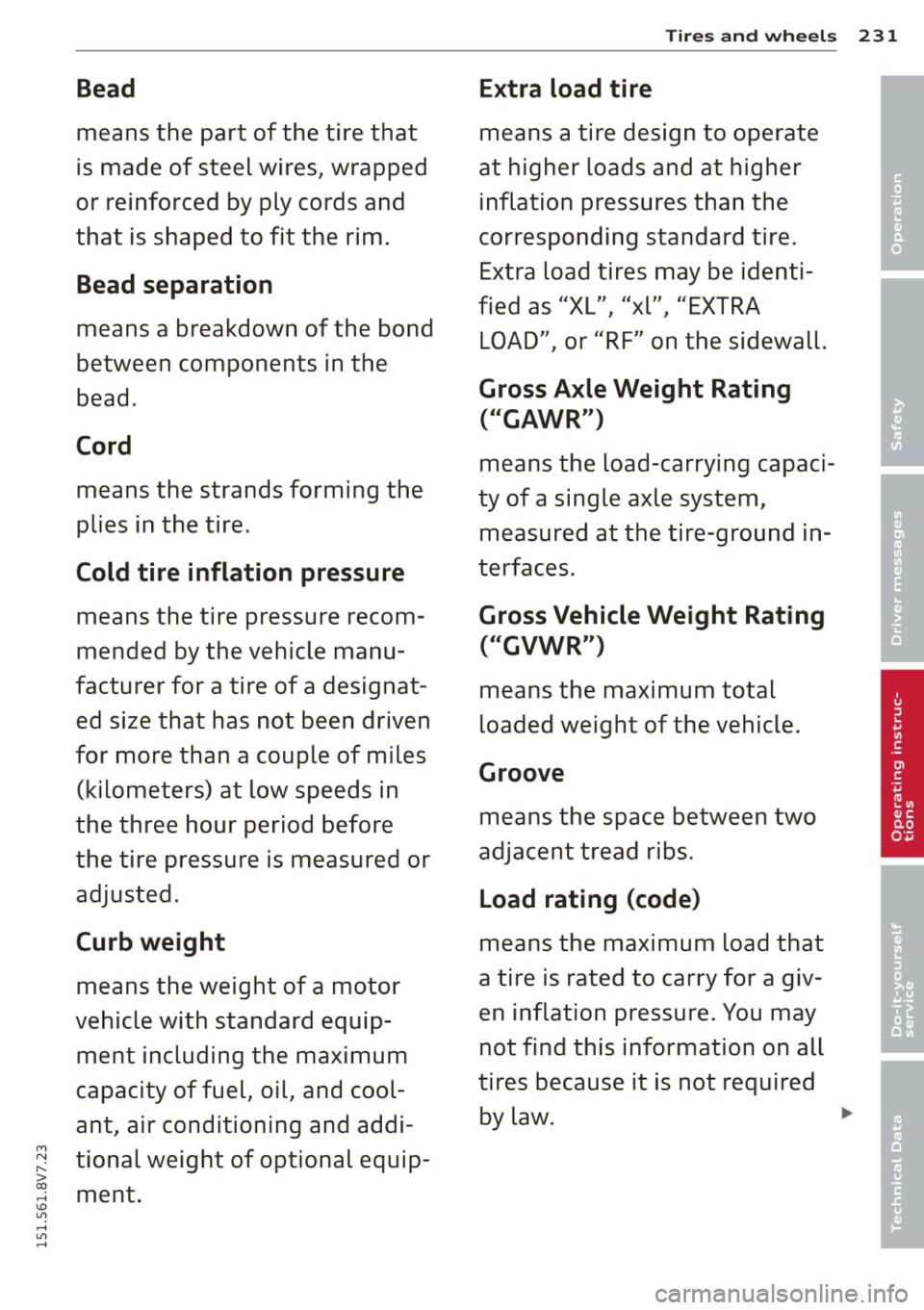
M N
" > co ,...., \!) 1.1'1 ,...., 1.1'1 ,....,
Bead
means the part of the tire that
is made of steel wires, wrapped
or reinforced by ply cords and
that is shaped to fit the rim.
Bead separation
means a breakdown of the bond
between components in the
bead.
Cord
means the strands forming the
plies in the tire .
Cold tire inflation pressure
means the tire pressure recom
mended by the vehicle manu
facturer for a tire of a designat
ed size that has not been driven
for more than a couple of miles (kilometers) at low speeds in
the three hour period before
the tire pressure is measured or
adjusted.
Curb weight
means the weight of a motor
vehicle with standard equip
ment including the maximum
capacity of fuel, oil, and cool
ant, air conditioning and addi
tional weight of optional equip
ment.
Tires and wheels 231
Extra load tire
means a tire design to operate
at higher loads and at higher inflation pressures than the
corresponding standard tire. Extra load tires may be identi
fied as "XL", "xl", "EXTRA
LOAD", or "RF" on the sidewall.
Gross Axle Weight Rating ("GAWR")
means the load-carrying capaci
ty of a single axle system,
measured at the tire-ground in
terfaces.
Gross Vehicle Weight Rating ("GVWR")
means the maximum total
loaded weight of the vehicle.
Groove
means the space between two
adjacent tread ribs.
Load rating (code)
means the maximum load that
a tire is rated to carry for a giv
en inflation pressure. You may
not find this information on all
tires because it is not required by law.
' •
•
' •
Page 234 of 302
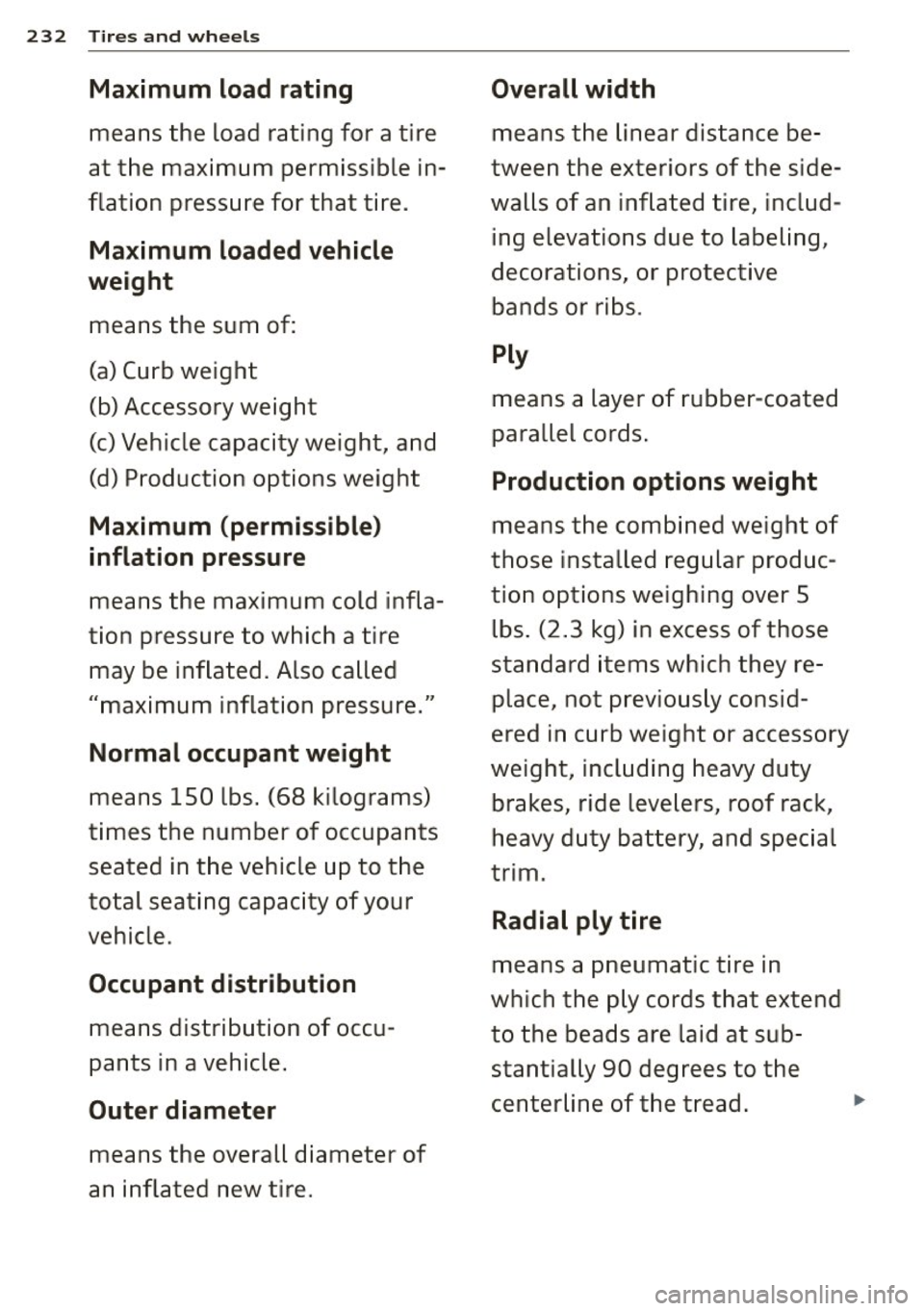
232 Tires a nd whee ls
Ma ximum load rating
means the load rating for a tire
at the maximum permissible in
flation pressure for that tire.
Maximum loaded vehicle
weight
means the sum of:
(a) Curb weight
(b) Accessory weight
(c) Vehicle capacity weight, and
(d) Production options weight
Maximum (permissible)
inflation pressure
means the maximum cold infla
tion pressure to which a tire
may be inflated. Also called
"maximum inflation pressure."
Normal occupant weight
means 150 lbs. (68 k ilograms)
times the number of occupants seated in the vehicle up to the
total seat ing capac ity of your
vehicle.
Occupant distribution
means distribution of occu
pants in a vehicle .
Outer diameter
means the overall diameter of
an inflated new tire.
Overall width
means the linear distance be
tween the ex teriors of the side
walls of an inflated tire, includ
ing elevations due to labeling,
decorations, or protect ive
bands or ribs .
Ply
means a layer of rubber -coated
parallel cords .
Production options weight
means the comb ined we ight of
those installed regular produc
tion op tions weighing over 5
lbs . (2. 3 kg) in excess of those
standard items which they re
place, no t prev iously consid
ered in curb weight or accessory
weight , incl uding heavy duty
brakes, ride leve lers, roof rac k,
heavy duty bat tery, and spec ial
trim.
Radial ply tire
means a pneumatic tire in
wh ich the p ly c ords that extend
t o the beads are laid at sub
stantially 90 degrees to the
centerline of the t read .
Page 235 of 302
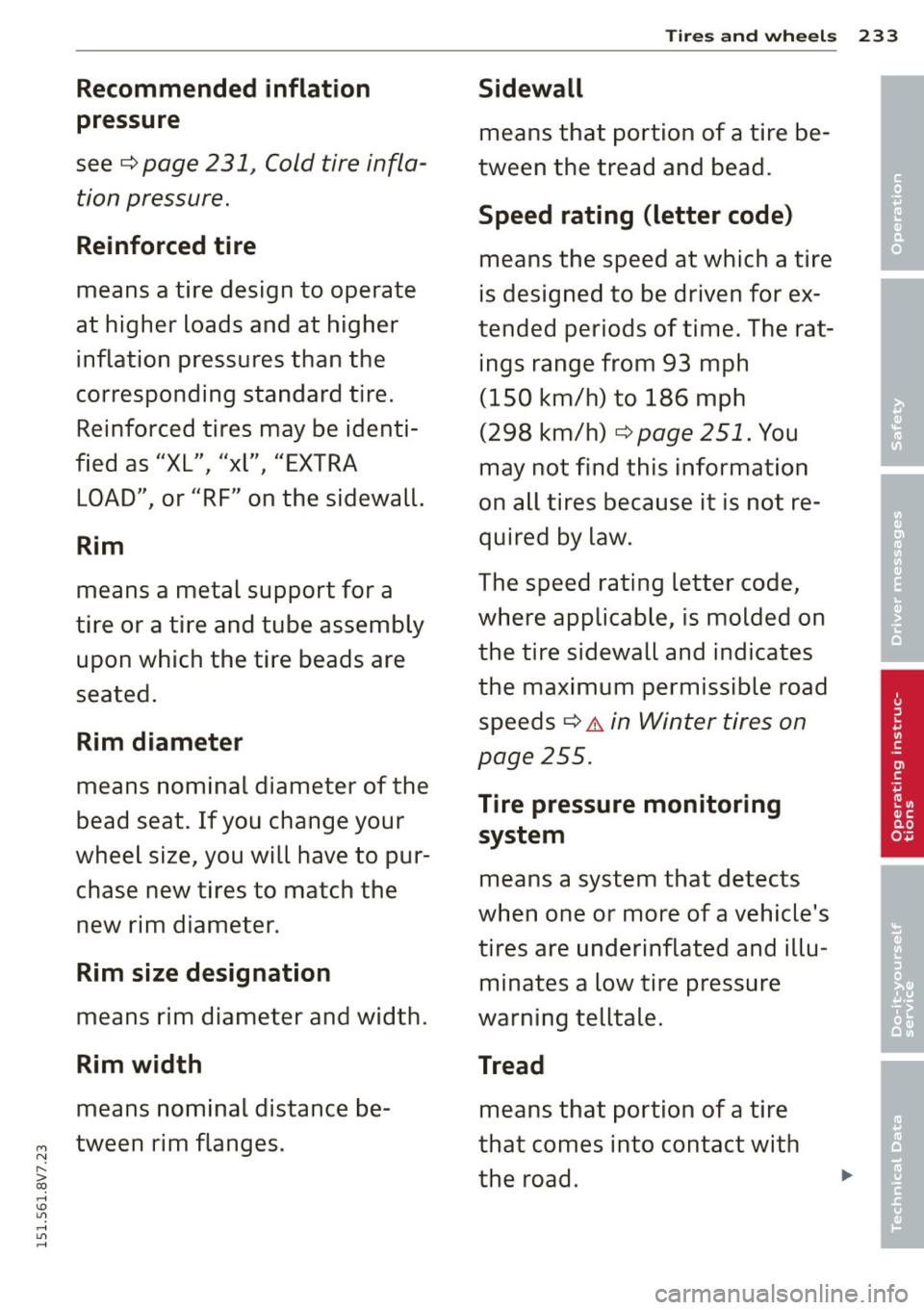
M N
" > co ,...., \!) 1.1'1 ,...., 1.1'1 ,....,
Recommended inflation
pressure
see¢ page 231J Cold tire infla
tion pressure.
Reinforced tire
means a tire design to operate
at higher loads and at higher
inflation pressures than the
corresponding standard tire. Reinforced tires may be identi
fied as "XL", "xl", "EXTRA
LOAD", or "RF" on the sidewall.
Rim
means a metal support for a
tire or a tire and tube assembly
upon which the tire beads are
seated.
Rim diameter
means nominal diameter of the
bead seat. If you change your
wheel size, you will have to pur chase new ti res to match the
new rim diameter.
Rim size designation
means rim diameter and width.
Rim width
means nominal distance be
tween rim flanges.
Tires and wheels 233
Sidewall
means that portion of a tire be
tween the tread and bead.
Speed rating (letter code)
means the speed at which a tire
is designed to be driven for ex
tended periods of time. The rat ings range from 93 mph
(150 km/h) to 186 mph
(298 km/h) ¢
page 251. You
may not find this information
on all tires because it is not re
quired by law.
The speed rating letter code,
where applicable, is molded on
the tire sidewall and indicates
the maximum permissible road speeds ¢
& in Winter tires on
page 255.
Tire pressure monitoring system
means a system that detects
when one or more of a vehicle's
tires are underinflated and illu
minates a low tire pressure
warning telltale.
Tread
means that portion of a tire
that comes into contact with
the road.
' •
•
' •
Page 236 of 302
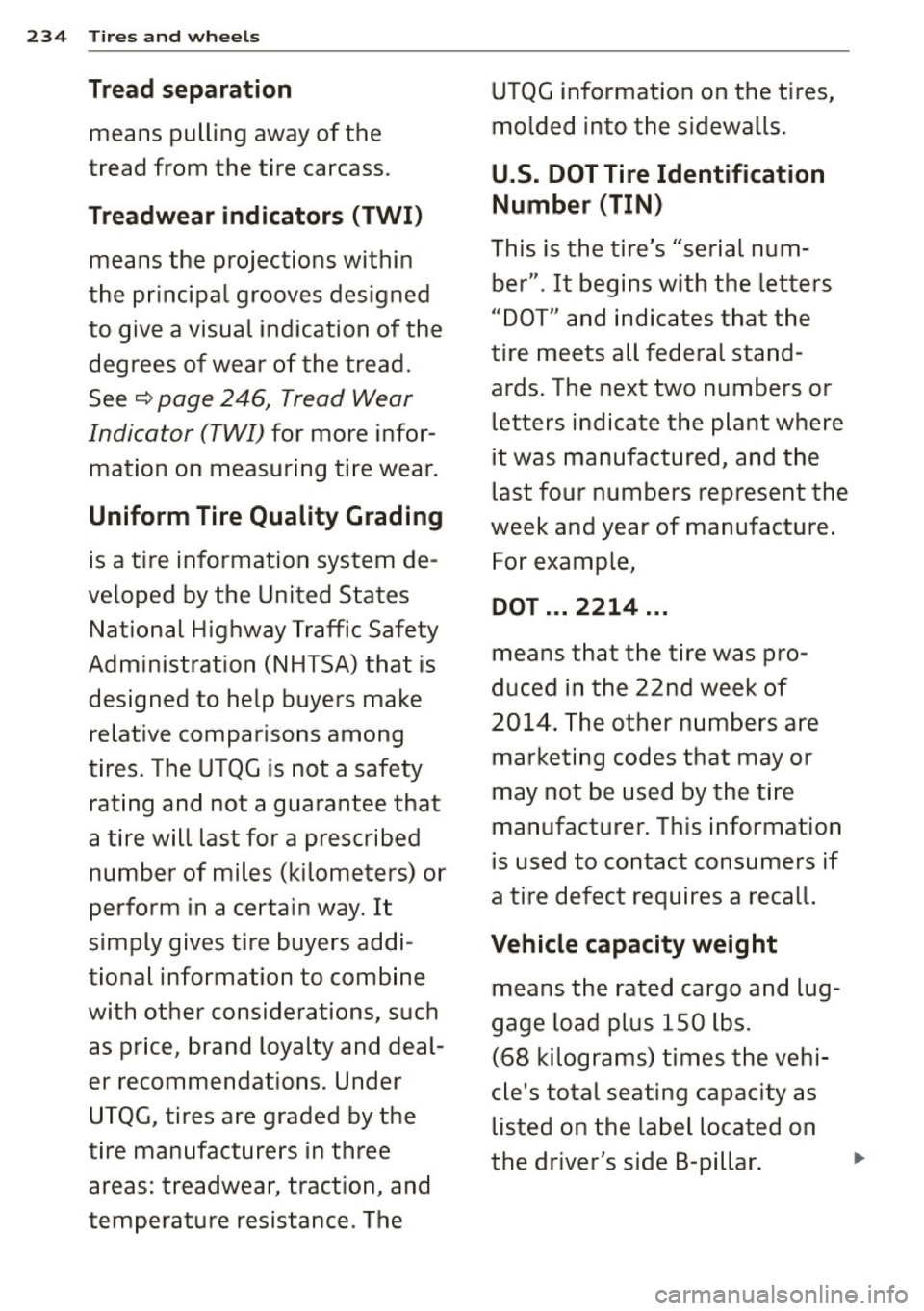
234 Tir es and whee ls
Tread separation
means pulling away of the
tread from the tire carcass .
Treadwear indicators (TWI )
means the projections with in
the principal grooves designed
to give a visual indication of the degrees of wear of the tread.
See
¢ page 246, Tread Wear
Indicator (TWI)
for more infor
mation on measuring tire wear .
Uniform Tire Quality Grading
is a tire information system de
veloped by the United States
National Highway Traffic Safety
Administration (NHTSA) that is
designed to help buyers make
relative comparisons among
tires. The UTQG is not a safety
rat ing and not a guarantee that
a tire will last for a prescribed
number of miles (kilometers) or
perform in a certain way. It
simply gives tire buyers addi
tional information to comb ine
with other considerations, such as price, brand loyalty and deal
er recommendations. Under
UTQG, tires are graded by the
tire manufacturers in three areas: treadwear, traction, and
temperature resistance . The UTQG information on the t
ires
molded into the sidewalls.
U.S. DOT Tire Identification
Numbe r (TIN )
,
This is the tire's "serial num
ber" . It begins with the letters
"DOT" and indicates that the
tire meets all federal stand
ards . The next two numbers or
letters indicate the plant where
it was manufactured, and the
last four numbers represent the
week and year of manufacture. F or example,
DO T ... 2214 ...
means that the tire was pro
duced in the 22nd week of
2014. The other numbers are
marketing codes that may or
may not be used by the tire
manufacturer. This information
is used to contact consumers if
a tire defect requires a recall.
Vehicle capacity weight
means the rated cargo and lug
gage load plus 150 lbs. (68 kilograms) times the vehi
cle's total seating capacity as
listed on the label located on
the driver's side B-pillar . .,..
Page 237 of 302
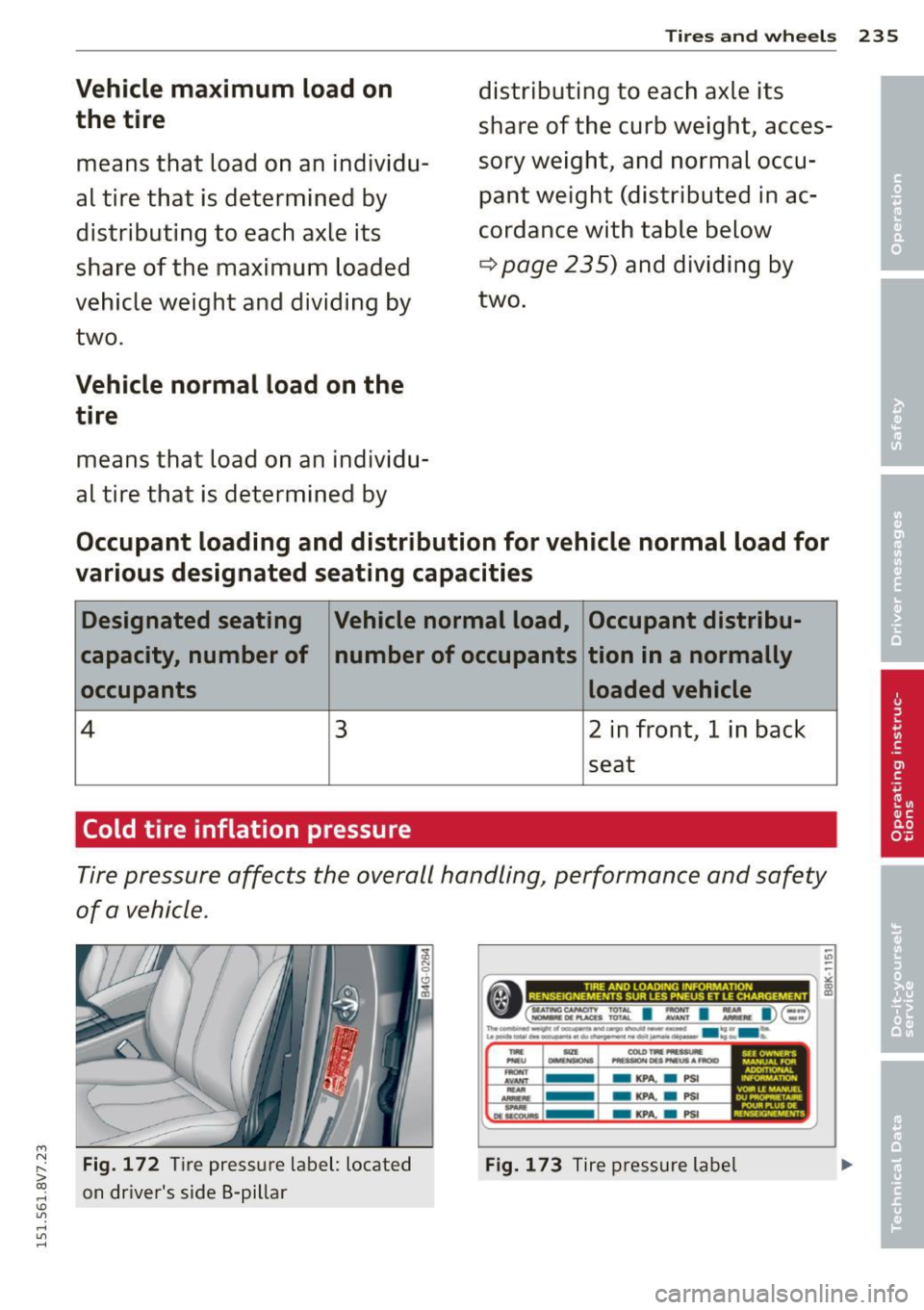
....,
N
r--. > co
rl I.O
"' rl
"' rl
Vehicle maximum load on the tire
means that load on an individu
al tire that is determined by
distributing to each axle its
share of the maximum loaded
vehicle weight and dividing by two.
Vehicle normal load on the tire
means that load on an individu
al tire that is determined by
Tires and wheels 235
distributing to each axle its
share of the curb weight, acces
sory weight, and normal occu pant weight (distributed in ac
cordance with table below
¢ page 235) and dividing by
two.
Occupant loading and distribution for vehicle normal load for
various designated seating capacities
Designated seating Vehicle normal load, Occupant distribu-
capacity, number of number of occupants tion in a normally
occupants loaded vehicle
4 3 2 in front, 1 in back
seat
Cold tire inflation pressure
Tire pressure affects the overall handling, performance and safety
of a vehicle.
Fig. 172 Ti re pressure label: located
on driver's s ide B -pillar
""" -,.._ u net:MHW>NS
-.....
--.,._
- KPA. a PSI
- KPA.
a PSI
-KPA. a PSI
Fig. 173 Tire pressure label
"'
Page 238 of 302
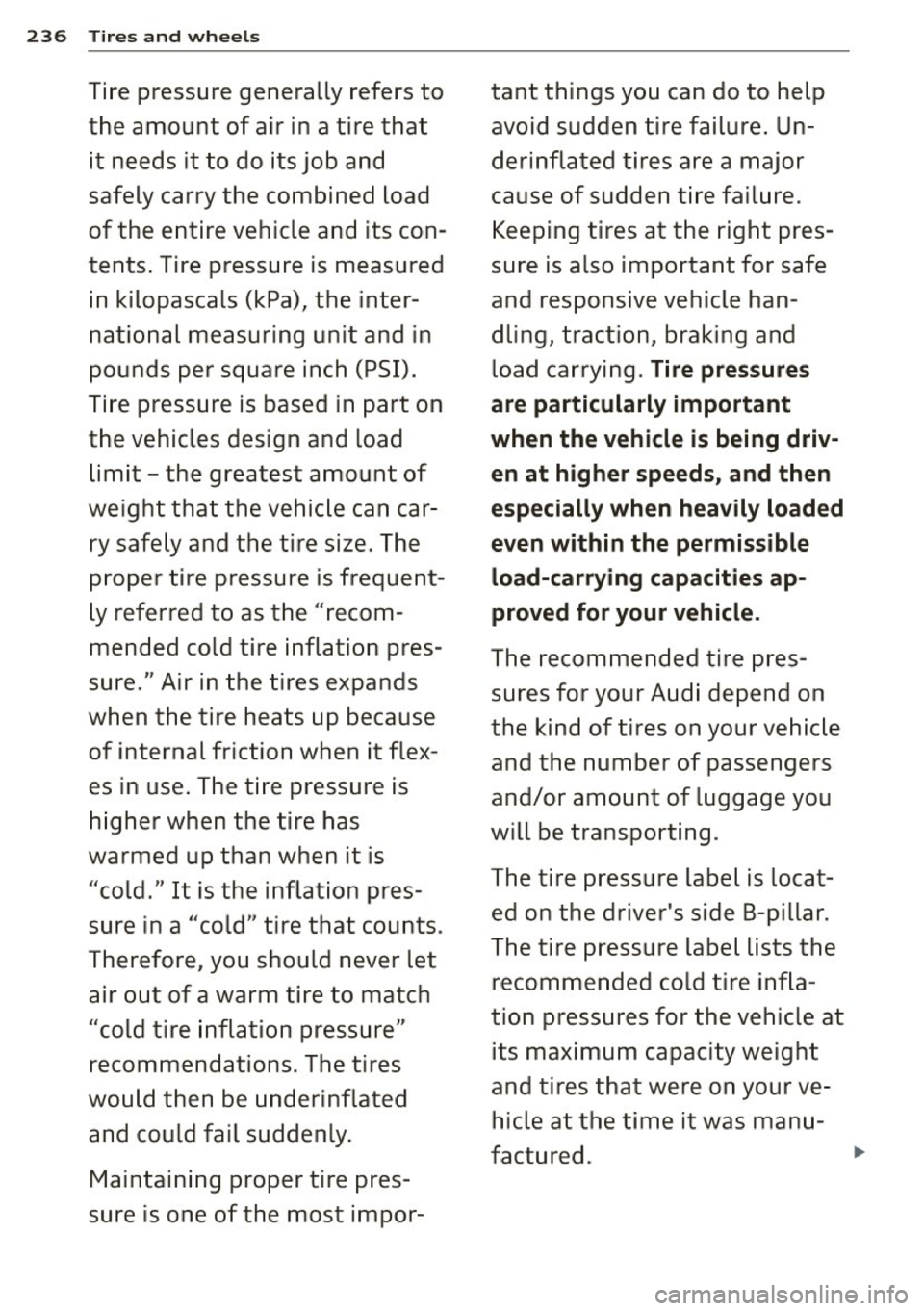
236 Tires and wheels
Tire pressure generally refers to tant things you can do to help
the amount of air in a tire that avoid sudden tire failure. Un-
it needs it to do its job and derinflated tires are a major
safely carry the combined load cause of sudden tire failure.
of the entire vehicle and its con- Keeping tires at the right pres-
tents. Tire pressure is measured sure is also important for safe in kilopascals (kPa), the inter-and responsive vehicle han-
national measuring unit and in dling, traction, braking and
pounds per square inch (PSI). load carrying.
Tire pressures
Tire pressure is based in part on are particularly important
the vehicles design and load when the vehicle is being driv-
limit -the greatest amount of en at higher speeds, and then
weight that the vehicle can car-especially when heavily loaded
ry safely and the tire size. The even within the permissible
proper tire pressure is frequent-load-carrying capacities ap-
ly referred to as the "recom-proved for your vehicle.
mended cold tire inflation pres-
The recommended tire pres-
sure." Air in the tires expands
sures for your Audi depend on
when the tire heats up because the kind of tires on your vehicle
of internal friction when it flex-
and the number of passengers
es in use. The tire pressure is
and/or amount of luggage you
higher when the tire has will be transporting.
warmed up than when it is The tire pressure label is locat-
"cold." It is the inflation pres-
ed on the driver's side 8-pillar.
sure in a "cold " tire that counts .
Therefore, you should never let The tire pressure label lists the
recommended cold t ire infla-
air out of a warm tire to match
"cold tire inflation pressure" tion pressures for the vehicle at
its maximum capacity weight
recommendations. The tires
would then be underinflated and tires that were on your ve-
and could fail suddenly. hicle at the time it was manu-
factured .
...
Maintaining proper tire pres-
sure is one of the most impor-
Page 239 of 302
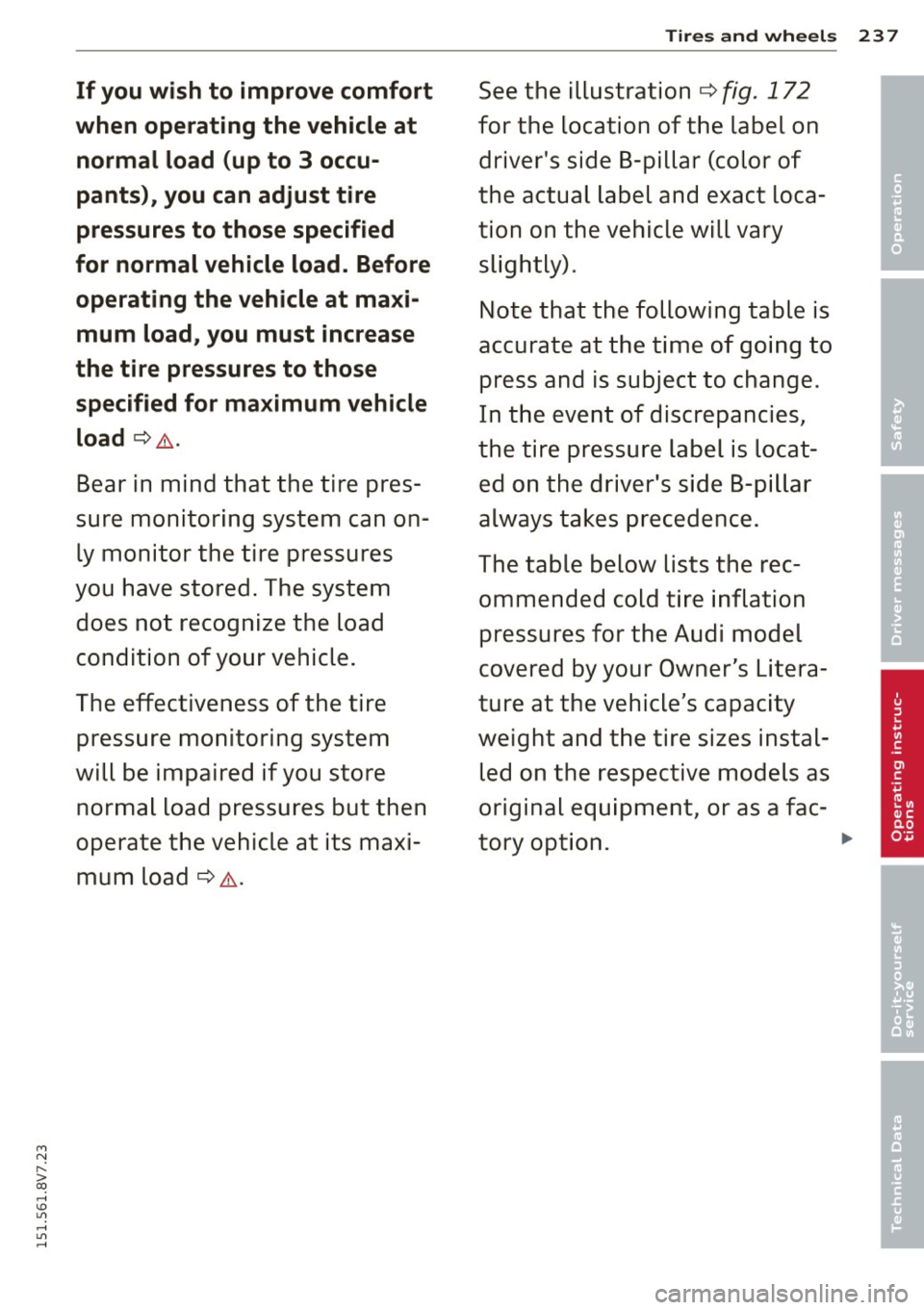
M N
" > co ...... \!) 1.1'1
...... 1.1'1 ......
If you wish to improve comfort
when operating the vehicle at
normal load (up to 3 occu
pants), you can adjust tire
pressures to those specified
for normal vehicle load. Before
operating the vehicle at maxi mum load, you must increase
the tire pressures to those
specified for maximum vehicle
load
c> .&. .
Bear in mind that the tire pres
sure monitoring system can on
ly monitor the tire pressures
you have stored. The system does not recognize the load
condition of your vehicle.
The effectiveness of the tire pressure monitoring system
will be impaired if you store normal load pressures but then
operate the vehicle at its maxi
mum load
c> .&. .
Tires and wheels 237
See the illustration c> fig. 172
for the location of the label on
driver's side B-pillar (color of
the actual label and exact loca
tion on the vehicle will vary slightly).
Note that the following table is
accurate at the time of going to
press and is subject to change.
In the event of discrepancies,
the tire pressure label is locat ed on the driver's side B-pillar
always takes precedence.
The table below lists the rec ommended cold tire inflation pressures for the Audi model
covered by your Owner's Litera
ture at the vehicle's capacity
weight and the tire sizes instal
led on the respective models as
original equipment, or as a fac-
tory option. ..,.
' •
•
' •
Page 240 of 302
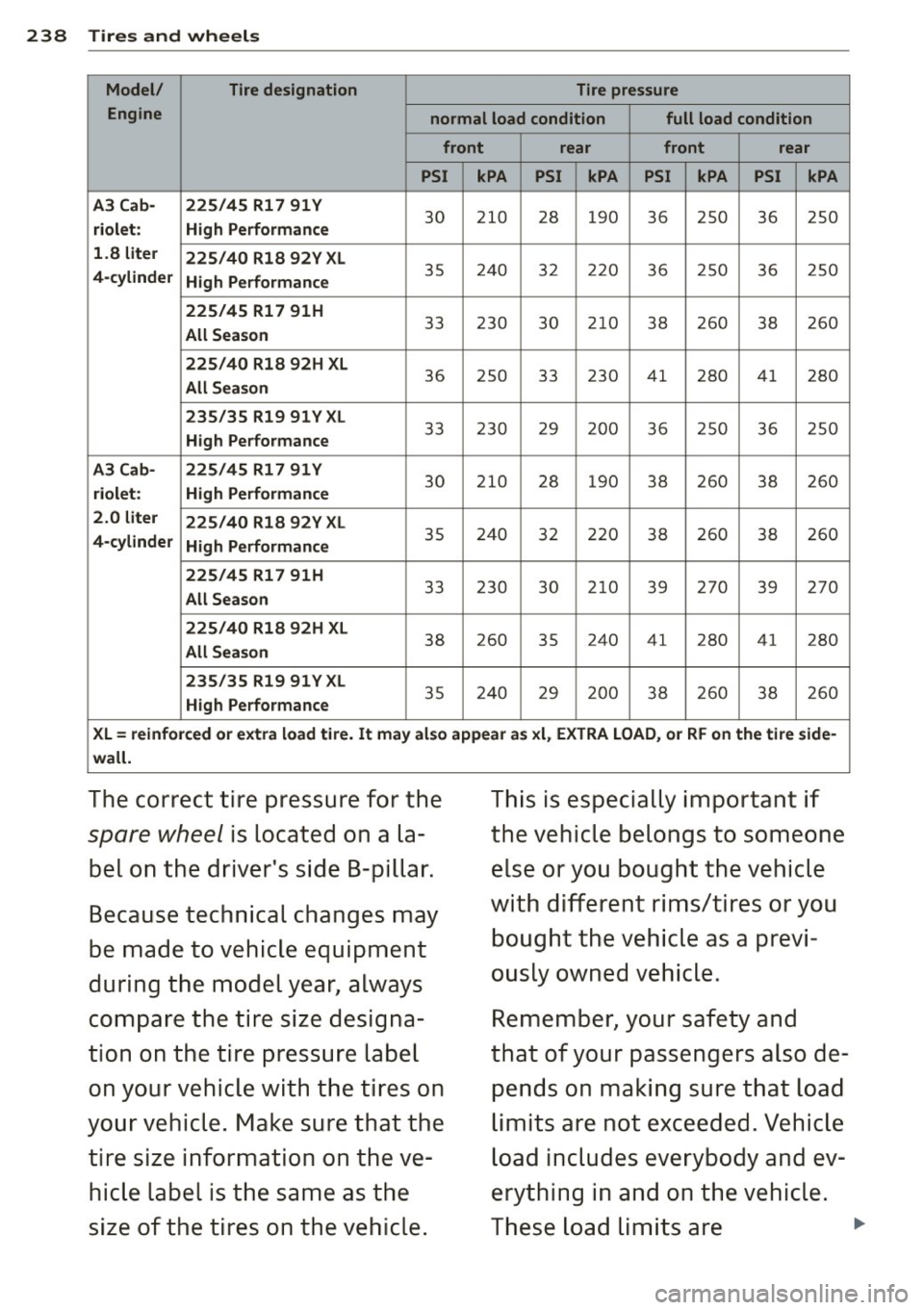
238 Tires and wheels
Model/ Tire designation Tire pressure
Engine normal load condition full load condition
front
rear front rear
PSI kPA PSI kPA PSI kPA PSI kPA
A3 Cab -225/45 Rl 7 91 Y
30 210 28 190 36 250 36 250 riolet : High Performance
1.8 liter 225/40 R18 92Y XL
4-cylinder High Performance
35 240 32 220 36 250 36 250
225/45 Rl7 91H
33 230
30 2
10
38 260
38 260 All Season
225/40 R18 92H XL
36 250 33 230 41 280 280 All Season 41
235/35 Rl9 91 Y XL
33 230 29 200 36 250 36 250 High Performance
A3 Cab- 225/45 Rl 7 91 Y
30 210 28 190 38 260 38 260 riolet: High Performance
2.0 liter
225/40 Rl8 92Y XL
4-cylinder High Performance
35 240 32 220 38 260 38 260
225/45 R17 91H
33 230 30 210 39
270
39 270 All Season
225/40 R18 92H XL
38 260 35 240 41 280 41
280
All Season
235/35 R19 91 Y XL
35 240 29 200 38 260 38 260 High Performance
XL= reinforced or extra load tire. It may also appear as xi, EXTRA LOAD, or RF on the tire side-
wall.
The correct tire pressure for the
spare wheel is located on a la
bel on the driver's side B-pillar.
Because technical changes may
be made to vehicle equipment
during the model year, always
compare the tire size designa
tion on the tire pressure label on your vehicle with the tires on
your vehicle. Make sure that the tire size information on the ve
hicle label is the same as the
size of the tires on the vehicle. This is
especially important if
the vehicle belongs to someone else or you bought the vehicle
with different rims/tires or you bought the vehicle as a previ
ously owned vehicle.
Remember, your safety and
that of your passengers also de pends on making sure that load
limits are not exceeded. Vehicle
load includes everybody and ev
erything in and on the vehicle.
These load limits are